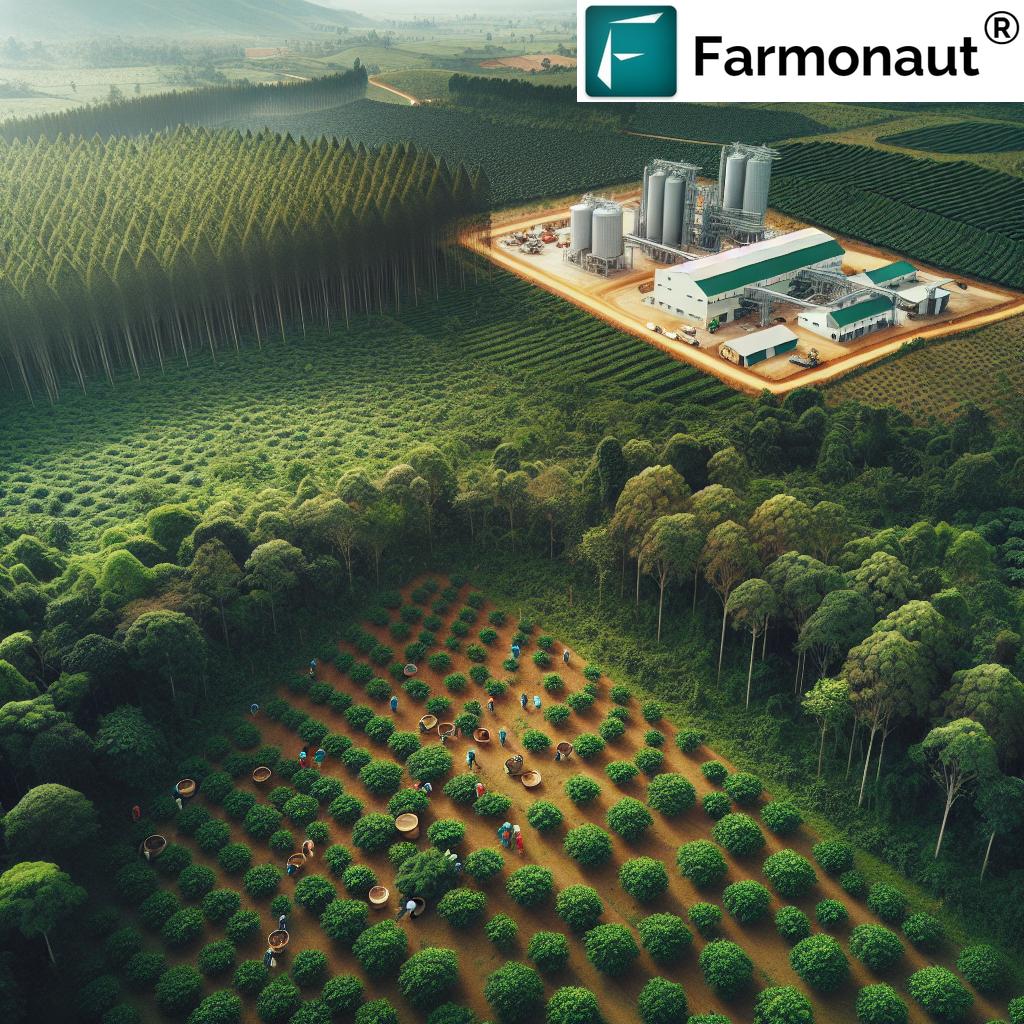Revolutionizing Sustainable Agriculture: How Eswatini’s Ubombo Reserve Combats Climate Change and Preserves Biodiversity
“Eswatini’s Ubombo Reserve, a 9,000-hectare nature reserve, is home to 331 bird species and 87 tree varieties.”
In the heart of Africa, nestled within the Kingdom of Eswatini, lies a remarkable testament to the power of sustainable agriculture and environmental conservation. The Ubombo Reserve, a 9,000-hectare sanctuary of biodiversity, stands as a beacon of hope in the face of climate change and ecological challenges. As we delve into this extraordinary landscape, we’ll explore how innovative farming practices and cutting-edge technology are reshaping the future of African agriculture while preserving crucial ecosystems.
Join us on a journey through the lush bushveld and vital wetlands of the Ubombo Reserve, where we’ll uncover the intricate balance between human activity and nature conservation. From the soaring eagles to the resilient indigenous trees, every aspect of this reserve tells a story of dedication to sustainability and biodiversity preservation.
The Ubombo Reserve: A Biodiversity Hotspot in Eswatini
The Ubombo Reserve is more than just a protected area; it’s a living laboratory for sustainable agriculture practices and environmental conservation in Africa. Recognized as a Ramsar Wetland of International Importance, this reserve showcases the potential for harmonious coexistence between agricultural production and wildlife conservation.
- 9,000 hectares of diverse habitats
- Home to 331 bird species
- Preserves 87 tree varieties crucial for carbon absorption
- Part of a larger 15,000-hectare conservancy
The reserve’s location in the Greater Big Bend area of Eswatini places it at the forefront of climate change mitigation strategies. By implementing innovative wildlife conservation initiatives and sustainable land management practices, the Ubombo Reserve is setting new standards for environmental stewardship in the region.

Biodiversity Preservation Techniques in Action
At the heart of the Ubombo Reserve’s success are its innovative biodiversity preservation techniques. These methods not only protect the existing flora and fauna but also create an environment where endangered species can thrive. Let’s explore some of the key strategies employed:
- Habitat Restoration: Careful rehabilitation of degraded areas to support native species
- Corridor Creation: Establishing wildlife corridors to allow safe movement of animals
- Invasive Species Management: Rigorous control of non-native plants and animals
- Water Resource Protection: Safeguarding wetlands and water sources vital for biodiversity
These techniques are complemented by cutting-edge agricultural technology, such as Farmonaut’s satellite-based farm management solutions. By integrating precision agriculture with conservation efforts, the reserve demonstrates how modern farming can support rather than hinder biodiversity.
Climate Change Mitigation: The Ubombo Approach
Climate change poses a significant threat to agriculture and biodiversity worldwide. The Ubombo Reserve tackles this challenge head-on with a multi-faceted approach to climate change mitigation:
- Carbon Sequestration: The reserve’s 87 tree varieties play a crucial role in absorbing carbon dioxide
- Sustainable Water Management: Innovative irrigation techniques reduce water waste and preserve wetlands
- Soil Conservation: Practices that prevent erosion and maintain soil health
- Renewable Energy Integration: Adoption of solar and wind power in agricultural operations
These strategies not only help combat the impacts of climate change but also serve as a model for other agricultural regions facing similar challenges. The reserve’s success in balancing productive farming with environmental protection showcases the potential for large-scale sustainable agriculture practices across Africa.
Wildlife Conservation Initiatives: Protecting Africa’s Natural Heritage
The Ubombo Reserve’s wildlife conservation initiatives span an impressive 15,000 hectares of conservancy land. These efforts are crucial in protecting some of Africa’s most iconic and endangered species. Key aspects of the wildlife conservation program include:
- Anti-Poaching Measures: Rigorous patrols and advanced surveillance to combat illegal hunting
- Species Monitoring: Regular surveys and tracking of animal populations
- Habitat Enhancement: Creating and maintaining optimal conditions for diverse wildlife
- Community Engagement: Involving local communities in conservation efforts
One of the reserve’s most notable achievements is its protection of 331 bird species, including rare and endangered raptors like eagles and vultures. This rich avian diversity not only contributes to the ecosystem’s health but also attracts birdwatching enthusiasts from around the world, supporting eco-tourism initiatives.
“The reserve’s conservation efforts span 15,000 hectares of land, showcasing sustainable agriculture practices and biodiversity preservation techniques.”
Sustainable Land Management: Balancing Agriculture and Conservation
At the core of the Ubombo Reserve’s success is its commitment to sustainable land management. This approach ensures that agricultural productivity coexists harmoniously with environmental conservation. Key practices include:
- Rotational Grazing: Optimizing pasture use while allowing land recovery
- Agroforestry: Integrating trees and shrubs into crop and animal farming systems
- Precision Farming: Utilizing technology to minimize resource use and environmental impact
- Organic Farming Methods: Reducing reliance on chemical inputs
These sustainable land management practices not only preserve the natural environment but also contribute to the long-term viability of agricultural operations. By demonstrating that productivity and conservation can go hand in hand, the Ubombo Reserve sets an example for agribusinesses across Africa.
Explore Farmonaut’s API for advanced agricultural insights
Wetland Conservation: Preserving Crucial Ecosystems
The wetlands within the Ubombo Reserve play a vital role in both biodiversity preservation and climate change mitigation. Recognized as a Ramsar Wetland of International Importance, these areas are subject to stringent protection and management. The importance of wetland conservation is multifaceted:
- Water Purification: Natural filtration of pollutants and sediments
- Flood Control: Absorption and slow release of excess water
- Carbon Storage: Wetlands are powerful carbon sinks
- Habitat Provision: Essential environments for numerous species
The reserve’s commitment to wetland conservation extends beyond mere protection. Active restoration projects and careful monitoring ensure these ecosystems continue to thrive, supporting both wildlife and sustainable agricultural practices in the surrounding areas.

Eco-Friendly Farming Methods: Innovation in Agriculture
The Ubombo Reserve is at the forefront of implementing eco-friendly farming methods that promote sustainability without compromising productivity. These innovative approaches include:
- Integrated Pest Management: Reducing chemical pesticide use through biological controls
- Conservation Tillage: Minimizing soil disturbance to maintain soil health
- Crop Rotation: Enhancing soil fertility and breaking pest cycles
- Water-Efficient Irrigation: Implementing drip and precision irrigation systems
By adopting these eco-friendly farming methods, the reserve not only reduces its environmental footprint but also produces high-quality crops that meet growing consumer demand for sustainably sourced products. This approach demonstrates how modern agriculture can thrive while prioritizing environmental stewardship.
Agricultural Technology for Sustainability: Farmonaut’s Role
In the quest for sustainable agriculture, cutting-edge technology plays a crucial role. Farmonaut, a pioneer in agricultural technology, offers advanced satellite-based farm management solutions that complement the Ubombo Reserve’s conservation efforts. Key features of Farmonaut’s technology include:
- Real-Time Crop Health Monitoring: Utilizing satellite imagery to assess vegetation health
- AI-Driven Advisory Systems: Providing personalized recommendations for optimal resource use
- Precision Resource Management: Enabling targeted application of water and inputs
- Carbon Footprint Tracking: Helping farms monitor and reduce their environmental impact
By integrating these technologies, the Ubombo Reserve can make data-driven decisions that support both agricultural productivity and environmental conservation. Farmonaut’s solutions empower farmers to optimize their practices, reducing waste and maximizing efficiency in harmony with nature.
Access Farmonaut’s API Developer Docs for advanced integration
Agri-Environmental Education Programs: Nurturing Future Stewards
The Ubombo Reserve recognizes that long-term sustainability depends on educating future generations. Its comprehensive agri-environmental education programs serve multiple purposes:
- Raising Awareness: Educating local communities about the importance of biodiversity
- Skill Development: Training in sustainable farming techniques
- Research Opportunities: Collaborating with universities for ecological studies
- Eco-Tourism: Offering educational tours and workshops for visitors
These programs not only enhance local capacity for sustainable land management but also foster a deep appreciation for the delicate balance between agriculture and nature. By involving communities and visitors in conservation efforts, the reserve ensures a lasting impact beyond its boundaries.
Impact on Local Communities and Ecosystems
The Ubombo Reserve’s initiatives have far-reaching effects on both local communities and surrounding ecosystems:
- Economic Benefits: Sustainable agriculture and eco-tourism create jobs and income
- Improved Food Security: Resilient farming practices ensure stable food production
- Enhanced Biodiversity: Conservation efforts support thriving ecosystems
- Climate Resilience: Sustainable practices help communities adapt to changing climate conditions
By demonstrating the viability of sustainable agriculture on a large scale, the reserve inspires similar initiatives across Africa. The positive impact on local livelihoods, coupled with environmental preservation, showcases a model for balanced development in rural areas.
Challenges and Future Directions
While the Ubombo Reserve has made significant strides in sustainable agriculture and biodiversity conservation, challenges remain:
- Climate Change Adaptation: Continuously evolving strategies to address changing weather patterns
- Balancing Development and Conservation: Managing pressure for land use change
- Funding for Long-Term Programs: Ensuring financial sustainability of conservation efforts
- Expanding Impact: Scaling successful practices to other regions
Looking ahead, the reserve aims to further integrate technology, expand its education programs, and strengthen partnerships with research institutions. By continuing to innovate and adapt, the Ubombo Reserve will remain at the forefront of sustainable agriculture and biodiversity preservation in Africa.
Biodiversity and Conservation Metrics at Ubombo Reserve
| Category | Metric | Value | Impact on Sustainability |
|---|---|---|---|
| Wildlife | Number of Bird Species | 331 | High |
| Flora | Tree Varieties | 87 | High |
| Conservation Efforts | Conservancy Land Area | 15,000 hectares | High |
| Protected Area | Nature Reserve Size | 9,000 hectares | High |
| Ecosystem Services | Wetland Recognition | Ramsar Site of International Importance | High |
Conclusion: A Model for Sustainable Agriculture in Africa
The Ubombo Reserve stands as a shining example of how sustainable agriculture practices and environmental conservation can coexist and thrive. By implementing innovative techniques, leveraging cutting-edge technology, and fostering community engagement, the reserve has created a blueprint for sustainable development that balances human needs with ecological preservation.
As we face the growing challenges of climate change and biodiversity loss, initiatives like the Ubombo Reserve offer hope and practical solutions. They demonstrate that with dedication, innovation, and collaborative efforts, we can create a future where agriculture not only feeds the world but also nurtures the planet.
The success of the Ubombo Reserve in Eswatini serves as an inspiration for similar projects across Africa and beyond. It shows that by embracing sustainable practices and harnessing the power of technology, we can revolutionize agriculture, combat climate change, and preserve the rich biodiversity that is essential for our planet’s health and our own survival.
FAQ Section
Q: What makes the Ubombo Reserve unique in terms of biodiversity?
A: The Ubombo Reserve is home to an impressive 331 bird species and 87 tree varieties, making it a biodiversity hotspot. Its recognition as a Ramsar Wetland of International Importance further underscores its ecological significance.
Q: How does the reserve contribute to climate change mitigation?
A: The reserve implements various strategies including carbon sequestration through its diverse tree population, sustainable water management, soil conservation practices, and the integration of renewable energy in its operations.
Q: What role does technology play in the reserve’s sustainable agriculture practices?
A: Advanced technologies, such as Farmonaut’s satellite-based farm management solutions, play a crucial role in monitoring crop health, optimizing resource use, and tracking environmental impact, all of which contribute to more sustainable farming practices.
Q: How does the reserve balance agricultural production with wildlife conservation?
A: The reserve employs sustainable land management practices, creates wildlife corridors, implements eco-friendly farming methods, and maintains protected areas to ensure that agricultural activities do not negatively impact wildlife habitats.
Q: What educational initiatives does the Ubombo Reserve offer?
A: The reserve provides comprehensive agri-environmental education programs, including awareness campaigns, skill development workshops, research opportunities, and eco-tourism activities to educate both local communities and visitors about sustainable practices and biodiversity conservation.
















